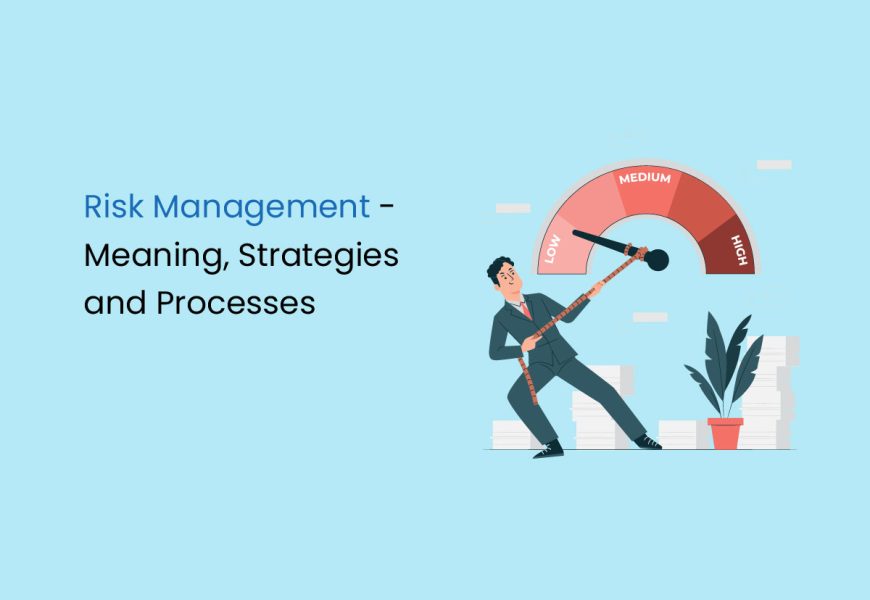Risk management involves systematically identifying, evaluating, and managing potential threats to an organisation’s financial, legal, strategic, and security interests. These risks, originating from diverse sources such as financial volatility, legal obligations, strategic missteps, accidents, and natural calamities, are assessed and controlled to safeguard the organisation’s capital and earnings.
In this article, we shall be taking a closer look into the topic, why it is important, types of risks and much more.
What is Risk Management?
Risk management involves identifying, analysing, and responding to various risk factors inherent in the operation of a business. It aims to control future outcomes by taking proactive measures rather than reacting to events as they occur. By effectively managing risks, businesses can mitigate the likelihood of risks occurring and minimise their potential impact on operations.
Why is Risk Management Important?
Risk management is crucial for organisations because it helps anticipate and prepare for potential unforeseen events that could impact operations. Without proper risk management measures in place, businesses may face various negative outcomes, ranging from minor disruptions to severe financial losses or even closure. By dedicating resources to minimise, monitor, and control the impact of negative events, organisations can better protect themselves and maximise positive outcomes. A systematic and integrated approach to risk management enables businesses to identify, manage, and mitigate significant risks effectively.
Types of Risks
When it comes to managing risk, organisations must distinguish between the different types of risks they face. Our research has identified three main categories of risks, each with its own characteristics and implications for the organisation’s strategy and survival.
Category I
Preventable risks are internal risks originating from within the organisation that are controllable and should be eliminated or avoided. These risks stem from unauthorised, illegal, unethical, incorrect, or inappropriate actions by employees or managers, as well as breakdowns in routine operational processes. While companies may tolerate some level of defects or errors that pose minimal harm, they generally aim to eliminate preventable risks altogether. Engaging in such risks may yield short-term profits, but over time, they erode the company’s value.
To effectively manage preventable risks, organisations should focus on active prevention by monitoring operational processes and guiding behaviours and decisions toward desired norms. While a comprehensive discussion of best practices in this area is beyond the scope of this article, interested readers can refer to the sidebar “Identifying and Managing Preventable Risks” for further insights.
Category II
Strategy risks are risks that a company willingly assumes as part of its strategic decisions to generate superior returns. For example, a bank takes on credit risk when it lends money, and companies may incur risks through their research and development activities.
Unlike preventable risks, strategy risks are not inherently undesirable. Instead, they are integral to pursuing opportunities for growth and innovation. Companies knowingly accept these risks because they are essential for achieving strategic objectives and realising potential rewards. For instance, BP accepted the substantial risks associated with deep-sea drilling in the Gulf of Mexico due to the significant value of the oil and gas reserves it aimed to extract.
Managing risk strategies requires a different approach than preventing risks. A rules-based control model is inadequate for handling these risks because they are inherent to the company’s strategic decisions. Instead, organisations need a robust risk-management system designed to mitigate the probability of risk occurrence and enhance the company’s capacity to manage or mitigate the impacts of such events. Such a system empowers companies to undertake higher-risk, higher-reward ventures compared to competitors with less effective risk management capabilities.
Category III
External risks originate from events outside the company’s sphere of influence and control. These risks are beyond the organisation’s ability to prevent or influence and often stem from factors such as natural disasters, political upheavals, and significant macroeconomic changes.
Unlike preventable and strategic risks arising from internal decisions and actions, external risks are largely unpredictable and uncontrollable. Consequently, companies must adopt a distinct approach to managing these risks. Since it is impossible to prevent such events from occurring, the emphasis shifts to identifying potential risks and implementing measures to mitigate their impact.
Managing external risks involves proactive identification of potential threats and vulnerabilities and developing contingency plans to respond effectively when adverse events occur. While these risks cannot be eliminated entirely, organisations can minimise their impact through robust risk mitigation strategies and adaptive resilience measures.
Companies encounter various risks, which can be classified into three distinct categories. Each category necessitates a different approach to risk management tailored to its unique characteristics.
| Category | Preventable Risks | Strategy Risks | External Risks |
|---|---|---|---|
| Description | Risks from within the company without strategic benefits | Risks taken for superior strategic returns | External, uncontrollable risk |
| Risk Mitigation Objective | Avoid or eliminate occurrence cost-effectively | Reduce likelihood and impact cost-effectively | Reduce impact cost-effectively should risk events occur |
| Control Model | Integrated culture-and-compliance model | Interactive discussions about risks to objectives | “Envisioning” risks through various assessments |
| Role of Risk-Management Staff Function | Coordinates, oversees, and revises specific risk controls | Runs risk workshops and review meetings | Helps develop risk initiatives and acts as devil’s advocates |
| Relationship to Business Units | Acts as independent overseers | Acts as independent facilitators, experts, or embedded experts | Complements strategy team or serves as an independent facilitator of “envisioning” exercises |
Why is Risk Communication Hard?
Communicating about risk can be challenging due to various cognitive biases and organisational barriers. Here are some reasons why discussing risk is difficult:
- Overconfidence: People often overestimate their ability to influence events and are overly confident in their forecasts and risk assessments.
- Narrow focus: There is a tendency to anchor estimates to readily available evidence, leading to linear extrapolations that may not accurately reflect future outcomes.
- Confirmation bias: Individuals tend to favour information that supports their existing beliefs and suppress information that contradicts them.
- Escalation of commitment: When events deviate from expectations, there is a tendency to irrationally commit even more resources to a failed course of action.
- Groupthink: Teams facing uncertainty may suppress dissenting opinions and conform to a dominant perspective, especially if led by an authoritative figure.
- Normalisation of deviance: Companies may become accustomed to minor failures and defects, treating early warning signals as false alarms rather than alerts to imminent danger.
To counteract these biases and barriers, effective risk-management processes must encourage open discussion and challenge assumptions. Simply relying on rules and checklists is not sufficient, as they may inhibit genuine dialogue about potential risks. Instead, fostering a culture where employees feel comfortable thinking and talking about risks is essential for effective risk management.
Risk Management Process
At its core, risk management is a comprehensive framework comprising people, processes, and technology to align organisational objectives with values and potential risks.
A robust risk assessment program should address legal, contractual, internal, social, and ethical considerations while staying abreast of emerging technology-related regulations. Prioritising risk awareness and allocating resources to manage and minimise risks can help businesses safeguard themselves against uncertainties, cut down on expenses, and enhance the prospects of sustained business operations and success.
The risk management process typically involves three key stages:
Identifying risks
Risk identification involves recognising and assessing potential threats to an organisation, its operations, and its workforce. This can encompass various scenarios, such as IT security vulnerabilities like malware and ransomware, accidents, natural disasters, and other adverse events that could disrupt business continuity.
Risk analysis and assessment
Risk analysis entails determining the likelihood of a risk event occurring and evaluating the potential consequences of each event. Risk evaluation involves comparing the magnitude of different risks and prioritising them based on their significance and potential impact.
Risk mitigation and monitoring
Risk mitigation involves developing strategies and measures to reduce the likelihood and impact of identified risks on project objectives. This may include implementing proactive measures to identify, monitor, and evaluate risks associated with specific projects, such as the development of a new product. Additionally, risk mitigation encompasses actions taken to address issues and mitigate their effects throughout the project lifecycle.
Risk management is a continuous and evolving process requiring regular assessment and adaptation. Repeating and consistently monitoring risk management processes can help ensure comprehensive coverage of both known and unknown risks, thereby enhancing organisational resilience and preparedness.
Risk Management Strategies
There are five commonly accepted strategies for addressing risk. The process typically starts with an initial consideration of risk avoidance, followed by three additional avenues: transfer, spreading, and reduction. Ideally, these three approaches work together in harmony as part of a comprehensive risk management strategy. However, it’s important to note that even after implementing these strategies, some residual risks may still remain.
What are the most common responses to risk?
Risk avoidance
Risk avoidance involves mitigating risk by refraining from engaging in activities that could potentially harm the organisation. For instance, choosing not to invest in a particular venture or launch a new product line can help avoid the risk of financial loss associated with these activities.
Risk reduction
Risk reduction focuses on minimising the impact of potential losses rather than completely eliminating them. This approach acknowledges the existence of risk but aims to limit its extent and prevent it from spreading. An example of risk reduction is implementing preventive measures in healthcare to mitigate the risk of illness or injury.
Risk sharing
Risk sharing involves distributing the potential losses among multiple parties, thereby reducing the burden on any single individual or entity. This strategy is commonly observed in corporate settings, where investors pool their resources to bear the risk associated with the enterprise’s operations collectively.
Transferring risk
Transferring risk entails contractually shifting the responsibility for potential losses to a third party, such as an insurance company. By purchasing insurance coverage for property damage or liability, organisations transfer the financial risk associated with these events to the insurer.
Risk acceptance and retention
After implementing risk-sharing, risk-transfer, and risk-reduction measures, some level of residual risk may still remain. Risk acceptance involves acknowledging this remaining risk and deciding to retain it within the organisation. Despite efforts to mitigate risk, it is often impractical or impossible to eliminate all potential risks entirely, except through risk avoidance. This residual risk is known as retained risk.
Limitations and Standards
Risk management standards outline a specific set of strategic processes that begin with an organisation’s objectives and aim to identify and mitigate risks through best practices.
Collaborative agencies often develop these standards to promote common goals and ensure the implementation of high-quality risk management processes. For instance, the ISO 31 000 standard is an internationally recognised standard that offers principles and guidelines for effective risk management.
While adopting a risk management standard offers various benefits, it also presents challenges. Implementing a new standard may require adjusting existing practices and introducing new working methods. Additionally, the standards may need to be tailored to fit the specific industry or business requirements.
FAQs on Risk Management
What are the Key Steps in Risk Management?
The key steps in risk management include:
- Identification: Recognizing potential risks.
- Analysis: Assessing the probability and impact of identified risks.
- Prioritisation: Ranking risks based on their significance.
- Treatment: Implementing measures to mitigate or manage risks.
- Monitoring: Continuously tracking and reassessing risks over time.
What Types of Risk Management Strategies Are There?
There are five primary strategies for managing risks:
- Avoidance: Steering clear of activities that pose significant risks.
- Retention: Accepting the risks and handling any consequences internally.
- Spreading: Distributing risks across various entities or portfolios.
- Prevention and Reduction: Implementing measures to minimise the likelihood or impact of risks.
- Transfer: Shifting risks to third parties through mechanisms such as insurance or contracts.
What Principles Guide Effective Risk Management?
The following principles guide effective risk management:
- Structured Approach: Establishing a systematic process for identifying, assessing, and addressing risks.
- Alignment with Objectives: Ensuring that risk management efforts align with organisational goals.
- Prioritisation: Giving priority to risks based on their potential impact and likelihood.
- Communication: Maintaining clear communication channels to share risk-related information.
- Adaptability: Being flexible and responsive to changing circumstances to manage risks effectively.
What Are the Key Activities Involved in Risk Management?
The key activities associated with risk management, often referred to as the 7 R's, include:
- Recognition: Identifying potential risks.
- Ranking: Prioritizing risks based on their severity and impact.
- Response: Developing strategies to address significant risks.
- Resource Allocation: Allocating resources to implement risk mitigation measures.
- Reaction Planning: Planning for potential risk events and their aftermath.
- Reporting: Communicating risk-related information to stakeholders.
- Review: Evaluating and refining the risk management process regularly.














